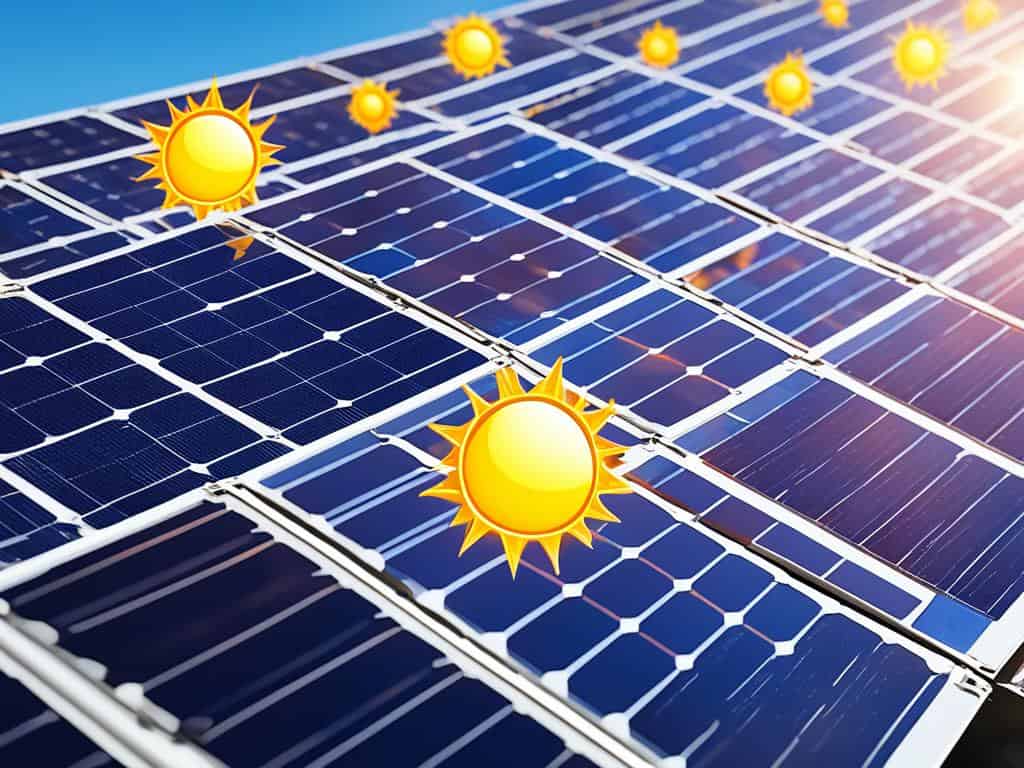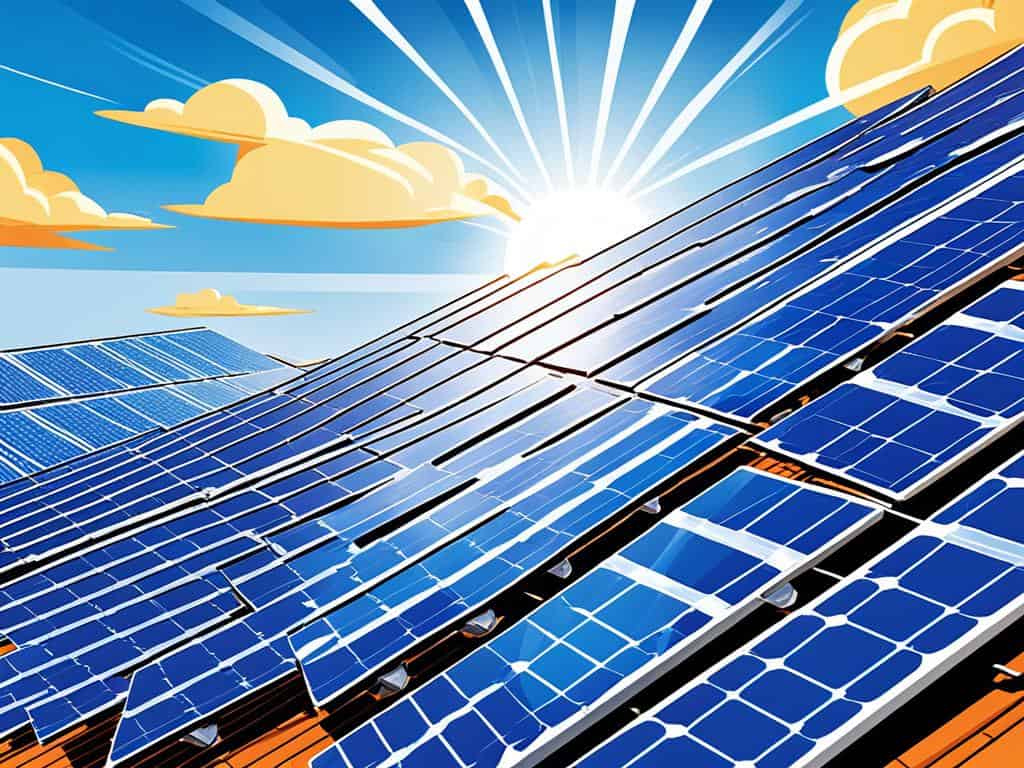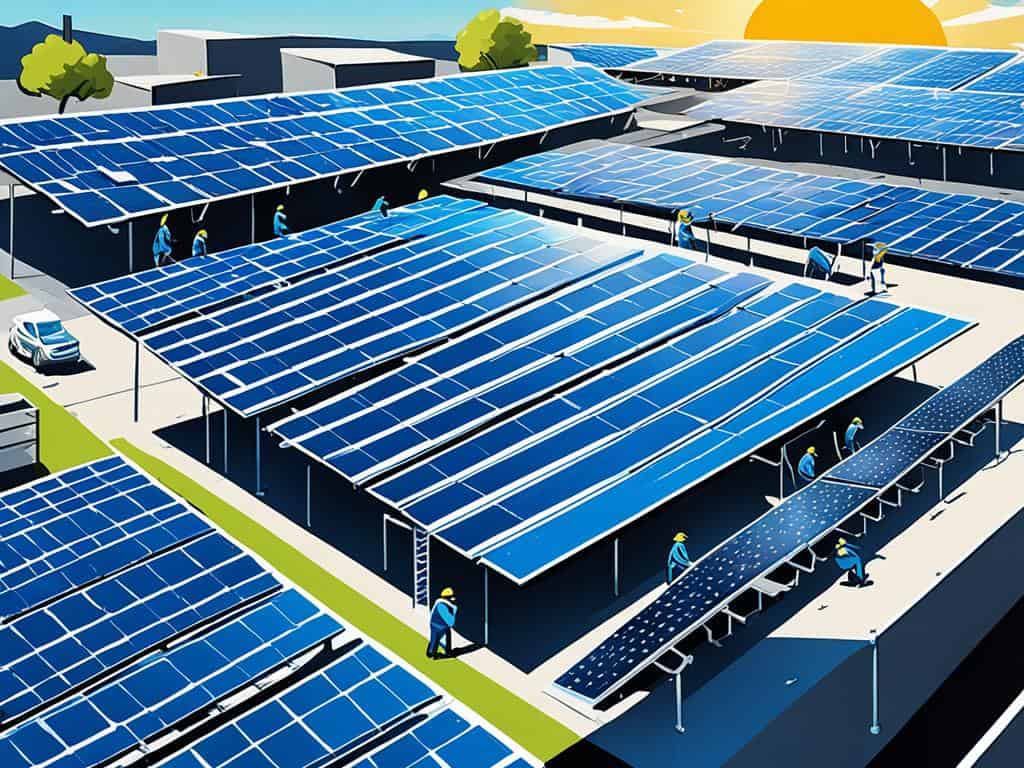Best Efficient Solar Panels in India 2024
Explore the best options for energy sustainability with our guide to the most efficient solar panels in India, perfect for the Indian climate.

India is sunny and perfect for solar energy. Fenice Energy has been leading in clean energy for over 20 years. They help make India sustainable. The most efficient solar panels in India turn lots of sunlight into power, using every ray well.
The top rated solar panels do more than just convert energy. They last long and work well in India’s weather. Fenice Energy offers energy efficient solar panels that look good and perform great in various climates.
Since 1881, solar technology has come a long way. Modern panels are much better thanks to past innovations. Fenice Energy gives Indian homes advanced and efficient solar solutions.
Key Takeaways
- Understanding the most efficient solar panels in India, tailored for peak performance and energy savings.
- Revealing how top rated solar panels cater to India’s versatile environmental conditions and maximize the use of solar energy.
- The significance of energy efficient solar panels in reducing carbon footprint and achieving energy independence.
- Insights into the advancements in photovoltaic technology and their impact on the sustainability of solar panel systems.
- A look at the strategic innovation by Fenice Energy, aligning with India’s sustainability goals and consumer needs.
Evolving Solar Technologies and Their Relevance in India’s Climate
India is targeting to get 50% of its power from renewable energy by 2030. To reach this goal, it’s crucial to have high-performance solar panels that work well in the Indian climate. Fenice Energy focuses on delivering best solar panels for Indian climate. These panels can handle the high heat and varied monsoon conditions.

Prime Minister Narendra Modi’s vision is for India to have 500 gigawatts of renewable energy by a certain year. In this vision, bi-facial modules and Monocrystalline PERC panels are leading the way. The Panasonic HIT Kuro Black 325W panels are top-notch for India’s extreme temperatures, showing the best of what solar tech can offer.
India is determined to boost its energy supply with renewable sources. This shift could lead to an $80 billion market by 2030. Fenice Energy plans to meet this growing demand with advanced technology. Their efforts are part of India’s mix of renewable energy that’s setting up a more eco-friendly future.
- India’s achievement of over 40% power from non-fossil fuels beats its COP21 promises early.
- Efforts like Indian Railways’ net-zero plan and the UJALA LED bulb campaign are cutting emissions by millions of tonnes each year.
- India is also focusing on green hydrogen production, showing a strong push for new energy solutions.
The road ahead is tough because India’s electricity use per person is lower than the world average. This challenge means there’s a big chance for growth in solar energy to meet rising power needs sustainably. Fenice Energy supports these goals by offering durable, efficient, and affordable solar panels suited to India’s climate.
As part of the International Solar Alliance, India is a key player in the move to cleaner power. Fenice Energy’s work with top solar panels for India not only supports local energy changes. It also shows India’s role in leading the global charge towards a sustainable energy future.
Most Efficient Solar Panels in India
India is stepping into a greener future. It’s doing this with the Star Labelling Programme for solar panels. Fenice Energy is leading with high-tech highest performing solar panels in India. These efforts will cut down carbon emissions by 30 million tonnes by 2030.
Adani Eternal Shine Series: Advanced PERC Technology
Adani’s Eternal Shine Series shows India’s skill in solar power, using PERC technology. The new rule requires 100% Made in India solar panels. The Eternal Shine Series meets top standards for durability and efficiency.
Goldi Solar’s Record-Breaking Mono PERC Technology
Goldi Solar is advancing fast with its Mono PERC 540W panels. Its Mono PERC technology ensures high power and can handle India’s hot climate. This is a big win for solar energy.
REC’s Alpha Pure R Series: Sustainable HJT Panels
REC focuses on green tech with its Alpha Pure R Series. These HJT technology panels combine efficiency and eco-friendliness. They support India’s goal for clean energy.
Adani Elan Shine Bifacial Modules: Dual Sided Innovation
Adani’s Elan Shine Bifacial PV Modules capture sunlight from both sides. This bifacial technology can boost efficiency by up to 30%. It’s a smart way to use India’s sunlight to grow the sector.
The Star Labelling Programme by the Bureau of Energy Efficiency (BEE) starts from January 1, 2024, to December 31, 2025. It pushes for efficient PV modules for both makers and users.
| Star Rating | Additional Electricity Generation |
|---|---|
| 1-Star to 2-Star | Approx. 12% |
| 4-Star | Up to 29% |
| 5-Star | Up to 35% |
This programme aims to increase electricity by 33GWh/year. It also plans to cut down 27,000 tons of CO2 each year. Changing star ratings on a 10 square-meter roof can greatly improve generation.
Currently, 15 appliances in India must have labels, and 19 others are optional. This shows a steady move towards products that are better for the environment and more efficient.

There is a strong push for high-performing solar panels in India. Using PERC technology, bifacial technology, and HJT technology sets new standards. This shows Fenice Energy’s commitment to India’s clean energy future.
Cost-Effectiveness and Performance: Key Features to Consider

In India, the clean energy market is growing fast. Investing in solar panels is a smart choice for saving money and helping the planet. The need for sustainable energy makes solar panels a practical choice in India. Investing in the right solar technology saves a lot of money and energy over time.
Choosing high-performance solar panels is more than just saving costs. It’s about lowering our carbon footprint and supporting future clean energy. With Fenice Energy’s help, you get cost savings and a greener future.
| Attribute | Cost-Effective Solar Panel | Conventional Energy Source |
|---|---|---|
| Energy Cost (India) | Progressively decreases over time | Subject to inflation and market fluctuations |
| Carbon Footprint | Minimal to none | Significant, dependent on fossil fuels |
| Long-Term ROI | High due to low operational costs | Variable, often lower compared to solar |
| Performance Warranties | Up to 25 years (e.g., RenewSys) | N/A |
When looking at solar panels, consider not just the initial cost but long-term savings too. For example, switching to solar can save a lot of money compared to traditional energy. The initial cost of solar panels might seem high, but they pay off by cutting energy bills significantly.
Using solar power also helps the whole community. It makes the power grid more robust and protects the environment. As Fenice Energy suggests, solar panels are a wise and eco-friendly choice for India. They match India’s goal for a sustainable energy future well.
In summary, it’s important to think about both costs and benefits when choosing solar panels. They offer not just savings but also contribute to a sustainable and economically independent future.
Top Rated Solar Panels: A Closer Look at Efficiency and Reliability
The Indian market has warmly embraced solar energy, thanks to advancements in technology. The shift toward solar energy is driven by solar panels’ growing efficiency and reliability. These panels not only promote sustainable energy but also bring economic benefits to users.
RenewSys’s Quality-centric Durable Solutions
RenewSys is leading the way in setting quality standards in the Indian solar market. Being the first integrated PV manufacturer in India, it’s known for its high-quality offerings. Products like the Deserv Poly Crystalline 330 Wp and Deserv Mono PERC 535 Wp panels stand out.
These panels excel in India’s challenging weather, offering both high power and efficiency rates up to 20.60%. RenewSys’s commitment to quality and performance has placed it among the top solar panel manufacturers.
Canadian Solar’s High-Efficiency Dual-Cell Modules
Canadian Solar has also made a big impact in India with its efficient solar modules. The HiKu Mono PERC 455 Wp and the HiKu7 Mono Perc 600 Wp panels show off cutting-edge dual-cell technology. These modules are designed to last and help reduce electricity costs for both consumers and businesses in India.
The progress in solar technology underscores that efficiency involves more than just converting energy. It’s also about the sustainability and longevity of solar investments.
| Parameter | RenewSys Deserv Mono PERC 535 Wp | Canadian Solar HiKu7 Mono Perc 600 Wp |
|---|---|---|
| Efficiency | Up to 20.60% | – |
| Technology | Mono PERC | Mono PERC Dual-Cell |
| Weather Resilience | High | High |
| Power Degradation Rate | Low | Low |
| Warranty | Product Warranty: 10 Years, Power Output: 25 Years | Product Warranty: 10 Years, Power Output: 25 Years |
Reliable solar panels from RenewSys and Canadian Solar mark a continuing move toward high-efficiency solar modules in India. These products meet quality standards and fit the economic needs of Indian consumers. This ensures the growth and staying power of the solar revolution.
Understanding Solar Panels Suited for Indian Conditions
India’s capacity for solar power hit 81.813 GWAC by 31 March 2024. There is a big push for solar parks. Knowing which solar panels work best in India’s climate is key. Fenice Energy is a leader in this area. The choice of solar tech depends largely on what’s best for the Indian weather. This means considering about 5,000 trillion kWh of solar energy from the sun. We look at key technologies like bifacial and DCR solar panels, and Mono PERC technology. Each serves different needs specific to India.
Bifacial Solar Panels: Best for Large Scale Applications
Bifacial panels make full use of India’s sunshine. They reflect light back onto the panel’s rear to capture more energy. These panels are great for India’s 42 solar parks
and are useful in industrial and commercial sectors. Properly placed, they catch sunlight from both sides. This boosts energy production beyond traditional panels.
DCR Solar Panels: The Dominance of Domestic Content
India wants to be self-reliant in solar tech, leading to DCR (Domestic Content Requirement) solar panels. These use local materials, support local industries, and help get government subsidies. The goal is a huge 40 GW in solar and hybrid projects for FY2023-24. DCR panels are key for reaching 100 GW of solar capacity. This builds a strong local solar manufacturing scene.
Mono PERC Solar Panels: The Preferred Choice for Homes
Homes with limited space and a need for efficiency choose Mono PERC tech. These panels offer a good mix of efficiency, cost, and space use. They’re perfect for homes
. Government subsidies and net metering make Mono PERC panels budget-friendly. They’re a smart choice for families wanting to cut electric bills and carbon footprints.
| State | Installed Capacity (MW) | Average Solar Rates (INR per kW) |
|---|---|---|
| Gujarat | 7,806 | 24,000 – 32,000 |
| Maharashtra | — | 25,000 – 35,000 |
| Tamil Nadu | — | 26,000 – 35,000 |
| Rajasthan | — | 23,000 – 30,000 |
| Karnataka | — | 25,000 – 33,000 |
Solar panel rates vary across states. Gujarat’s big solar market drives prices. While Rajasthan’s low rates and sunlight make it perfect for solar power. The right panel technology is crucial in hot places like Pavagada, Karnataka.
The growth of solar energy in India shows promise for a clean energy future. Fenice Energy is helping with this change. Choosing the right panels for India’s climate is key for our energy goals and economic growth.
Advancements in Solar Panel Manufacturing in India
India is moving fast toward its renewable energy goals, causing a boom in solar panel manufacturing. Now ranked 4th in the world for solar power, it shows a huge commitment to solar energy. From a small beginning, India’s solar capacity jumped to 70,096 MW in 2023 from 21,651 MW before.
The Make in India mission has received a big push from the government through the PLI scheme. This plan has a budget of INR 24,000 Cr to boost solar production in India. The goal is to create 50 Solar Parks with a total capacity of 38 GW by 2025-26.
The PM-KUSUM scheme is a key part of India’s renewable energy advancements. It aims to add 30.8 GW of solar power by March 2026. This ties into India’s goal to have 500 GW of renewable energy by 2030. The drive could create up to 6 million jobs by 2030, showing a bright economic and environmental future.
The Union Budget 2023-24 set aside INR 7,327 Cr for solar power, 48% more than last year. This shows the huge potential of India’s solar sector, estimated to be 7,48,990 MW.
Currently, India can make 3 GW of solar cells and 10 GW of solar PV modules a year. These numbers show India’s progress and its ability to meet both global and local demand. This advancement supports the Make in India mission.
New technologies like perovskite solar cells could make solar panels cheaper to produce. Community solar projects and floating solar farms are also becoming popular. With innovations like thin-film and bifacial solar cells, India is shaping the future of solar manufacturing worldwide.
Foreign investments in solar have reached over $14,858 Mn from April 2000 to June 2023. This shows the world trusts India’s solar sector. With over 250-300 sunny days a year, India’s energy future looks bright. It’s set to not only change its own path but influence the global clean energy scene, too.
Conclusion
India is making big strides in using solar power. The country now boasts an impressive 81.813 GWAC of solar energy capacity as of March 2024. This shift to solar energy marks a major change from traditional energy sources. Foreign investments of nearly INR 1.5 lakh crores over the past decade show the world’s trust in India’s green energy path.
Fenice Energy is a key player in boosting solar energy use in India. It supports the government’s goal to introduce 40 GW of solar and hybrid projects. The country has built about 42 solar parks, making it easier to start solar plants. India’s solar energy soared from 161 MW in 2010 to over 81 GW in 2024, highlighting the push for a cleaner future.
Most of Fenice Energy’s solar panels are in nine states, like Gujarat and Andhra Pradesh. These states are leading in increasing their solar power output. About 70% of all rooftop solar power, which was 2.1 GW by 2018, is used by businesses and factories. This expansion of solar technology in India strengthens its energy independence and positions it as a leader in the move towards a sustainable planet.
FAQ
Q: What are the most efficient solar panels in India for 2024?
A: In 2024, the top solar panels in India will use advanced tech like PERC, bifacial, and HJT. This increases their energy conversion rates. Look for names like Adani Eternal Shine Series, Goldi Solar’s Mono PERC panels, and REC’s Alpha Pure R Series. Adani’s Elan Shine Bifacial Modules are also expected to shine.
Q: How are evolving solar technologies relevant in India’s diverse climate?
A: New solar techs like PERC and HJT work well in India’s varied weather. They stay efficient in both extreme heat and low light. This makes them perfect for anywhere from the hot deserts to rainy areas.
Q: What makes the Adani Eternal Shine Series stand out?
A: The Adani Eternal Shine Series uses monocrystalline PERC tech. It’s known for its high efficiency and durability. It works well in India’s varied climate and fits different installation needs.
Q: Why is Goldi Solar’s Mono PERC technology record-breaking?
A: Goldi Solar’s Mono PERC tech is a game changer. It has boosted power output and efficiency, leading the solar energy market in India.
Q: What are the sustainability features of REC’s Alpha Pure R Series HJT Panels?
A: REC’s Alpha Pure R Series uses eco-friendly HJT tech. It’s lead-free, boosts efficiency, and lessens environmental harm. It meets global standards for green energy.
Q: How do Adani Elan Shine Bifacial Modules achieve Dual Sided Innovation?
A: Adani’s Elan Shine Bifacial Modules capture sunlight on both sides. The front takes in direct light while the back gathers reflected light. This unique feature can increase energy yield by up to 30%.
Q: When it comes to cost-effectiveness, which solar panels should consumers consider in India?
A: Look for panels that balance cost with long-term savings. Options like the Panasonic HIT Kuro Black and RenewSys products offer good deals. They come with extended warranties, making them budget-friendly choices.
Q: Which top rated solar panels are known for efficiency and reliability in the Indian market?
A: RenewSys’s Deserv range and Canadian Solar’s HiKu modules lead in efficiency and reliability. They’re built tough to withstand extreme weather, ensuring stable power.
Q: What type of solar panels are best suited for the Indian climate?
A: Different panels serve different needs in India. Bifacial panels are good for big industries, DCR panels help follow local rules, and Mono PERC is great for homes. Each type is designed for India’s diverse environment.
Q: How has solar panel manufacturing in India advanced?
A: India’s solar industry has grown a lot. Companies like Loom Solar Pvt Ltd are leading in home solar innovations. Thanks to the Make in India campaign, there’s a push for better efficiency and warranties that last up to 30 years.


